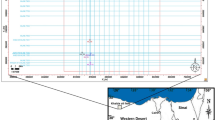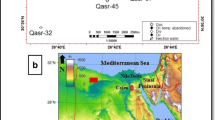Abstract
3D structural modeling is an effective technique for the 3D structural analysis of anticlines. The 3D interpretation of structures is most of the matter in the oil development of subsurface reservoirs. In this study, the 3D structural modeling was used for the analysis of Lab-e-Safid and Qale Nar subsurface anticlinal oilfields in the northern Dezful Embayment. The main objectives are determining the structural style in the different parts and the kinematic evolution modeling of these anticlines. 2D cross-sections, extracted from 3D models, were compared to 2D interpreted seismic profiles. Anticlines are formed above the intermediate décollement horizon in the northern Dezful Embayment. Structural style varies horizontally and vertically. Lab-e-Safid anticline shows an early step in the evolution path. In contrast, Qale Nar anticline indicates the final step of the evolution path. The Qale Nar anticline is a box fold in the western part and concentric fold in the central and eastern parts. The fold shape of Lab-e-Safid is stationary along the axial plane. Late-stage folding evolution is associated with the complexity structural style of folding. Progressive deformation of early detachment anticlines caused the development of folding followed by faulting in the forelimb.











Similar content being viewed by others
REFERENCES
M. B. Allen, C. Saville, E. J. P. Blanc, M. Talebian, and E. Nissen, “Orogenic plateau growth: Expansion of the Turkish-Iranian plateau across the fault-and-thrust belt,” Tectonics 32, 171–190 (2013).
I. Abdollahie Fard, A. Braathen, M. Mokhtari, and S. A. Alavi, “Interaction of the Zagros fold-thrust belt and the Arabian-type, deep-seated folds in the Abadan Plain and the Dezful Embayment, SW Iran,” Petrol. Geosci. 12, 347–362 (2006).
M. L. Bordenave and J. A. Hegre, “The influence of tectonics on the entrapment of oil in the Dezful Embayment, Zagros fold belt, Iran,” J. Petrol. Geol. 28, 339–368 (2005).
C. A. E. O’ Brien, “Tectonic problems of the oil field belt of Southwest Iran,” In: Proceedings of the 18th International Geological Congress (London, 1950), Pt. 6, pp. 45–58.
E. Carminati, L. Aldega, S. Bigi, G. Minelli, and A. Shaban, “The role of pre-collisional extensional faulting, salt tectonics and multi-stage thrusting in the Sarvestan transfer zone (Fars, Iran),” Tectonophysics 671, 235–248 (2016).
N. L. Falcon, “Problems of the relationship between surface structures and deep displacements illustrated by the Zagros range,” In: Time and Place in Orogeny. Vol. 3 of Geol. Soc. London, Ed. by P. Kent, G. E. Satterhwaite, and A. M. Spencer (London, 1969) pp. 9–22.
S. Jahani, J. P. Callot, J. Letouzey, and D. Frizon de Lamotte, “The eastern termination of the F-FATB, Iran: Structures, evolution, and relationships between salt plugs, folding, and faulting,” Tectonics 28, 1–22 (2009).
W. N. Kent and U. Dasgupta, “Structural evolution in response to fold and thrust belt tectonics in northern Assam: A key to hydrocarbon exploration in the Jaipur anticline area,” J. Mar. Pet. Geol. 21, 785–803 (2004).
H. Motamedi, S. Sherkati, and M. Sepehr, “Structural style variation and its impact on hydrocarbon traps in central Fars, Southern Zagros folded belt, Iran,” J. Struct. Geol. 37, 124–133 (2012).
H. Motiei, Stratigraphy of Zagros (Geol. Surv. Iran, Tehran, 1994).
S. Mitra, “A unified kinematic model for the evolution of décollement folds,” J. Struct. Geol. 25, 1659–1673 (2003).
S. Mitra, “Fault-propagation folds: geometry, kinematic evolution, and hydrocarbon traps,” Am. Assoc. Petrol. Geol. Bull. 74, 921–945 (1990).
S. Mukherjee and H. A. Koyi, “Higher Himalayan shear zone, Zanskar section by microstructural and extrusion mechanism by a combination of simple shear and channel flow,” Int. J. Earth Sci. 99, 1083–1110 (2010).
M. Najafi, A. Yassaghi, A. Bahroudi, J. Verges, and S. Sherkati, “Impact of the late Triassic Dashtak intermediate décollement horizon on anticline geometry in the central frontal Fars, SE Zagros Fold belt, Iran,” J. Mar. Pet. Geol. 54, 23–36 (2014).
J. Poblet and K. R. McClay, “Geometry and kinematic of single layer detachment folds,” Am. Assoc. Petrol. Geol. Bull. 80, 1085–1109 (1996).
R. Sarkarinejad, Razavi Pash, H. Motamedi, and M. Yazdani, “Deformation and kinematic evolution of the subsurface structures: Zagros foreland fold-and-thrust belt, northern Dezful Embayment, Iran,” Int. J. Earth Sci. 107, 1287–1304 (2017).
Schlumberger, “Seismic-to-simulation software,” In: Petrel Introduction Course Petrel (Iraq, Baghdad, 2008), pp. 50–334.
M. Sepehr and J. W. Cosgrove, “Structural framework of the Zagros fold-thrust belt, Iran,” J. Mar. Pet. Geol. 21, 829–843 (2004).
M. Sepehr, J. W. Cosgrove, and M. Moieni, “The impact of cover rock rheology on the style of folding in the Zagros fold-and-thrust belt,” Tectonophysics 427, 265–281 (2006).
S. Sherkati and J. Letouzey, “Variation of structural style and basin evolution in the central Zagros (Izeh zone and Dezful Embayment), Iran,” J. Mar. Pet. Geol. 21, 535–554 (2004).
S. Sherkati, J. Letouzey, and D. Frizon de Lamotte, “The Central Zagros fold-thrust belt (Iran): New insights from seismic data, field observation and sandbox modeling,” Tectonics 25, 1680–1696 (2005).
S. Sherkati, M. Molinaro, D. Frizon de Lamotte, and J. Letouzey, “Detachment folding in the Central and Eastern Zagros fold-belt (Iran): Salt mobility, multiple detachments and late basement control,” J. Struct. Geol. 27, 1680–1696 (2006).
V. T. Trocmé, E. Albouy, J. P. Callot, J. Letouzey, N. Rolland, H. Goodarzi, and S. Jahani, “3D structural modelling of the southern Zagros fold-and-thrust belt diapiric province,” Geol. Mag. 148, 879–900 (2011).
ACKNOWLEDGMENTS
The authors are indebted to the National Iranian South Oil Company (NISOC) for providing the wells data and seismic profiles for this study. This research was supported by the Shiraz University Research Council (SURC) grant for Ph.D. thesis which is gratefully acknowledged.
Author information
Authors and Affiliations
Corresponding author
Rights and permissions
About this article
Cite this article
Razavi Pash, R., Sarkarinejad, K., Zarehparvar Ghoochaninejad, H. et al. Application of 3D Structural Modeling to Analyze the Structural Geometry and Kinematic Evolution: A Case Study from Lab-e-Safid and Qale Nar Subsurface Anticlines in the Northern Dezful Embayment, Iran. Geotecton. 55, 261–272 (2021). https://doi.org/10.1134/S0016852121020072
Received:
Revised:
Accepted:
Published:
Issue Date:
DOI: https://doi.org/10.1134/S0016852121020072




